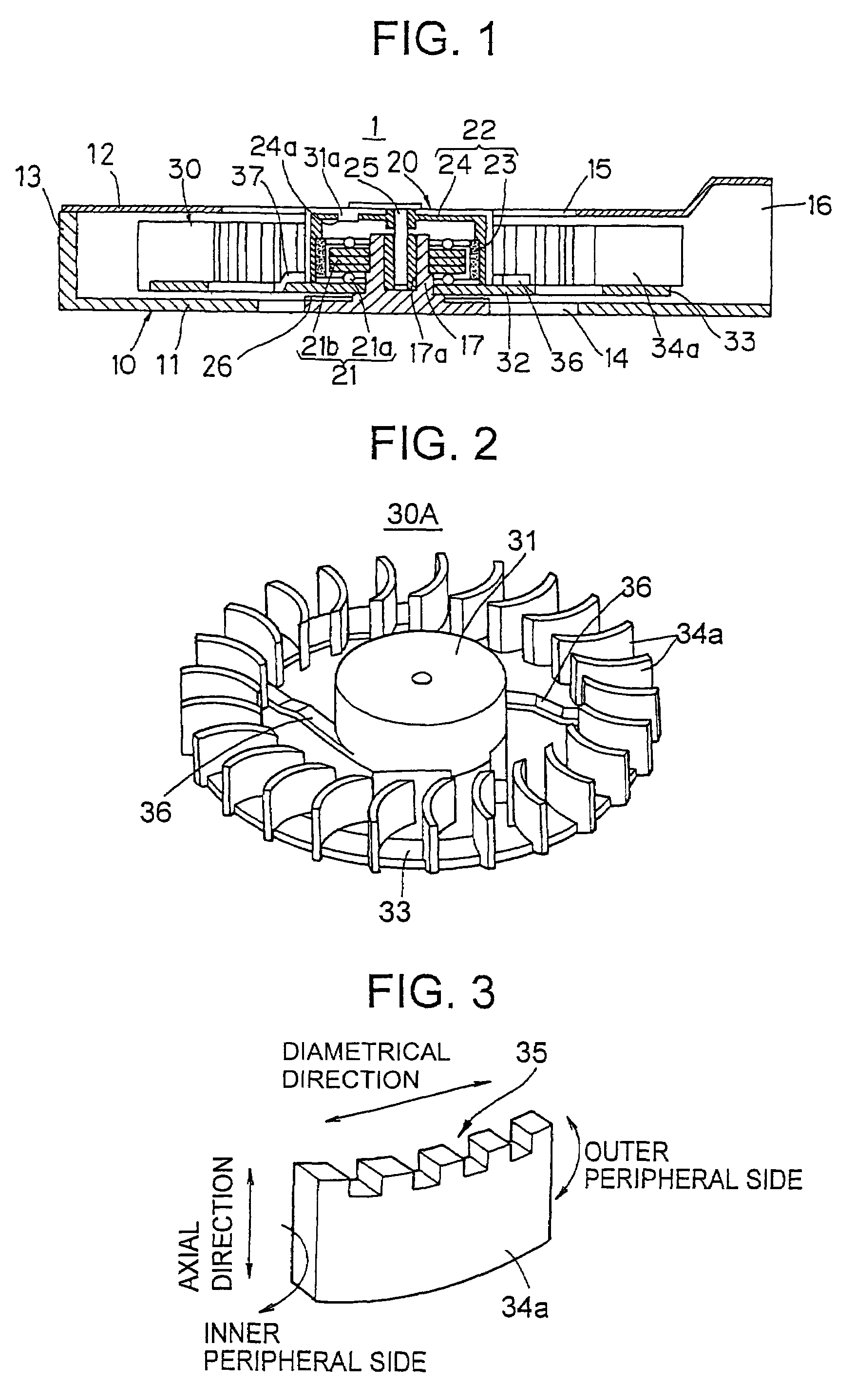Fan motor
a technology of fan motor and blade, which is applied in the direction of marine propulsion, vessel construction, and other chemical processes, can solve the problems of reduced effect of above structures, and reduced number of sawtoothed teeth, so as to reduce the noise of aerodynamics, improve ventilation efficiency, and manufacture inexpensively
- Summary
- Abstract
- Description
- Claims
- Application Information
AI Technical Summary
Benefits of technology
Problems solved by technology
Method used
Image
Examples
first embodiment
[0026]FIG. 1 shows a cross-sectional view of a fan motor according to an embodiment of the present invention; FIG. 2 shows an impeller of a fan motor; and FIG. 3 shows a configuration example of a blade of an impeller. Fan motor 1 is constituted by a flat-shaped housing 10, a motor 20 of an outer rotor type provided within the housing 10, and a resin impeller 30A integrally rotating with the rotor.
[0027]The housing 10 has inlets 14 and 15 on a lower wall 11 and an upper wall 12, respectively, which are connected to an inside of a blade 34a of the impeller 30A, and a blowport 16 on the one side of a side wall 13. In addition, in the central part of the lower wall 11, a hub section 17 having an aperture 17a is formed, which supports a stator 21 of the motor 20 and a rotating shaft 25 of a rotor 22.
[0028]The motor 20 is configured by an inner stator 21 constituted of a winding 21a and a core 21b, an outer rotor 22 constituted of a magnet 23 and a rotor case 24, a rotating shaft 25 prov...
second embodiment
[0039]FIG. 9 shows an impeller of a fan motor according to a second embodiment. The impeller 30B is configured by a hub section 31 formed so as to cover a rotor case 24 of a motor 20 (FIG. 1) and a plurality of blade sections 37 integrally formed with the hub section 31. The blade section 37 is constituted by blades 34c and an arm part 37a supporting the blades 34c. A length (width) of the arm part 37a in an axial direction is formed shorter than a length of the blade 34c in a diametrical direction in order to have enough space between inner surfaces of a lower wall 11 and of an upper wall 12 of a housing 10 (FIG. 1). The blade 34c is formed, as shown in FIG. 10, to have four pairs of the tooth structure 35 at its upper and lower edge ends in the diametrical direction.
[0040]Since the tooth structures are respectively provided at the upper and lower edge ends of the blade 34c in the diametrical direction, the turbulence is forcibly induced in the trailing vortex air flow generated at...
application example
[0042]In FIG. 12, a cooling module utilizing the fan motor according to the present invention is shown. In the figure, reference numeral 41 indicates a heat spreader of a module, which generates the heat largely (for example, a CPU), mounted on a notebook personal computer, reference numeral 42 is a plate-shaped heat pipe provided to the heat spreader, reference numeral 43 is a heat sink constituted by a plurality of heat dissipating fins provided to an upper surface of the heat pipe 42 on the waste-heat side, and reference numeral 1 is the fan motor according to the present invention, which has the impeller whose blade is formed to have the tooth structure or the chamfers at the edge end in the diametrical direction.
[0043]A blowport for sending air to the heat sink 43 in the housing 10 of the fan motor 1 is formed widely in order to send air toward a whole rear-end portion of the heat sink 43, and is provided on the heat pipe 42 so as to contact the rear-end portion of the heat sin...
PUM
 Login to View More
Login to View More Abstract
Description
Claims
Application Information
 Login to View More
Login to View More - R&D
- Intellectual Property
- Life Sciences
- Materials
- Tech Scout
- Unparalleled Data Quality
- Higher Quality Content
- 60% Fewer Hallucinations
Browse by: Latest US Patents, China's latest patents, Technical Efficacy Thesaurus, Application Domain, Technology Topic, Popular Technical Reports.
© 2025 PatSnap. All rights reserved.Legal|Privacy policy|Modern Slavery Act Transparency Statement|Sitemap|About US| Contact US: help@patsnap.com



